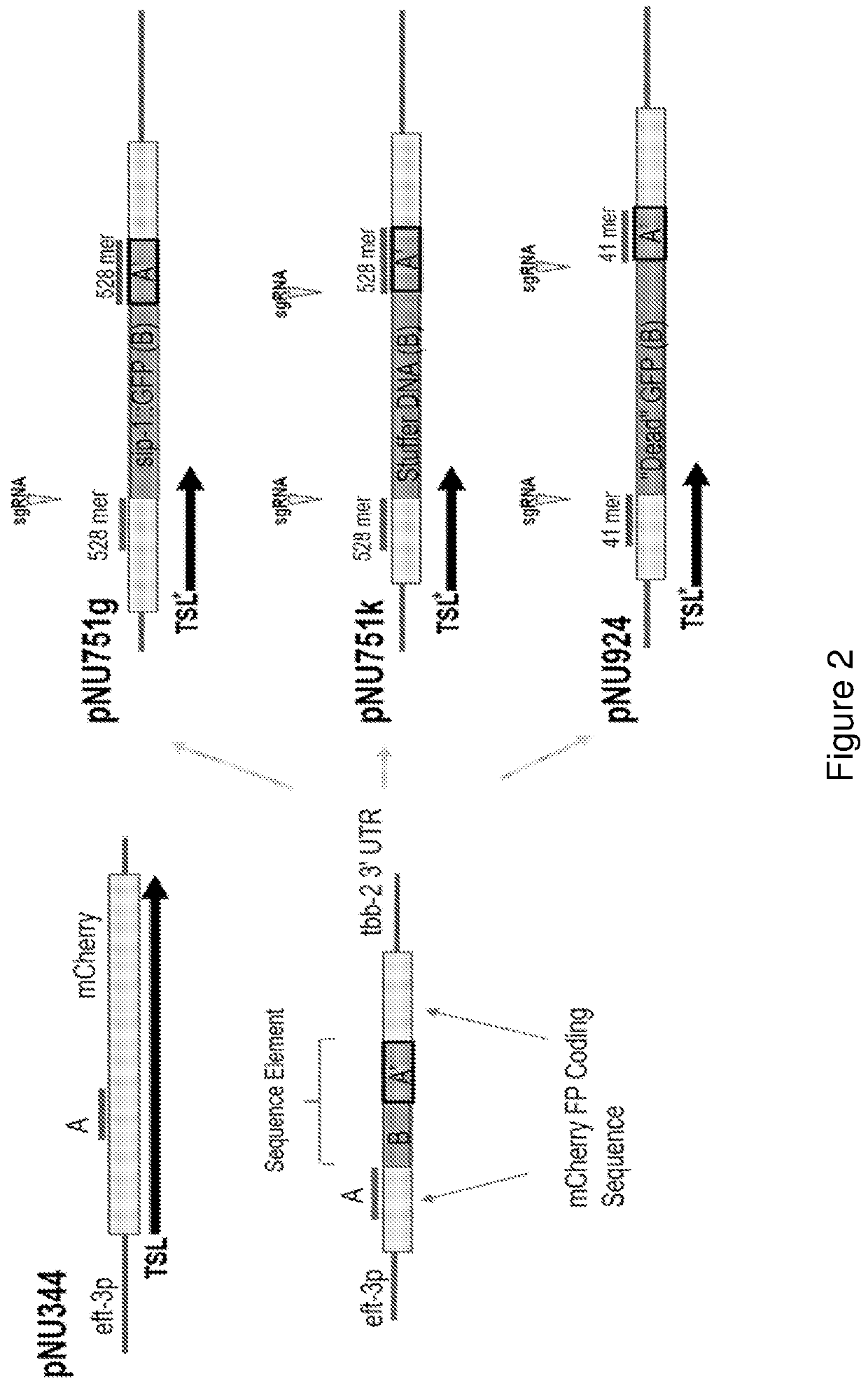Homologous Recombination Reporter Construct and Uses Thereof
- Summary
- Abstract
- Description
- Claims
- Application Information
AI Technical Summary
Benefits of technology
Problems solved by technology
Method used
Image
Examples
example 1
Preparation of Present Nucleic Acid Construct for Use in C. elegans
[0089]Provided herein are exemplary configurations of the present nucleic acid construct comprising a mutant fluorescent protein. See FIG. 2. The nucleic acid constructs prepared herein (HR-reporter) comprise a coding sequence for a fluorescent protein, mCherry in the examples below, that is interrupted by a sequence element that disrupts expression of a functional fluorescent protein and wherein the sequence element is removed with successful genomic gene editing in a host cell resulting in a functional fluorescent protein. The sequence element comprises an A′ segment that is a direct repeat of a coding sequence (A segment) of the fluorescent protein located directly upstream of the sequence element. The sequence element may include sgRNA site(s), that may span into the A and A′ segments. See FIG. 1B. Alternatively the sgRNA sites(s) may be wholly contained in the B segment. Endonuclease cleavage and activation of ...
example 2
Method of Increasing Likelihood of Detecting Successful Modification of a Specific Sequence in Chromosomal DNA of C. elegans Using CRISPR / Cas9
[0090]Nucleic acid constructs were prepared according to Example 1 and used in methods for detecting successful homologous recombination of a target sequence in C. elegans embryos. A mixture comprising a construct of FIG. 2 and Example 1, Cas9 and sgRNA that would recognize the sgRNA sequences of the construct along with a target donor homology template for dpy-10 gene and sgRNA were prepared. Injections resulting in successful homologous recombination as evidenced by HR-reporter fluorescence were screened for a target site edit at the dpy-10 locus. The edit at the dpy-10 locus creates the cn64 allele. The cn64 allele was chosen due to easy visual detection of a dominant Rol phenotype upon creation of a R108C edit in one copy of the dpy-10 gene (Levy A D et al. Mol Biol Cell. 1993 August; 4(8):803-17).
[0091]Three HR-reporter construct configur...
example 3
Enrichment for Bi-Allelic Conversion with the HR-Reporter
[0099]Nucleic acid constructs of Example 1 may be used in methods for detecting successful homologous recombination of a second target sequence in both chromosomes in C. elegans embryos. A mixture comprising a construct of FIG. 2 and Example 1, Cas9 and sgRNA that would recognize the sgRNA sequences of the construct along with a target donor homology template for insertion of the 3×FLAG tag in the fcd-2 gene locus and fcd-2 sgRNA were prepared. A second mixture using the same target site edit as above and the standard dpy-10 sgRNA and donor homology template as co-CRISPR was prepared for comparison. Table 1 shows the screening process and results for these two mixtures. Each mixture was injected into the gonads of 30 adult nematodes. For the C. elegans injected with the HR reporter plasmid, 24-hour post-injection plates were screened for red embryos and 6 / 30 plates were found. Five days post-injection plates from both sets of ...
PUM
| Property | Measurement | Unit |
|---|---|---|
| Fraction | aaaaa | aaaaa |
| Fraction | aaaaa | aaaaa |
| Fraction | aaaaa | aaaaa |
Abstract
Description
Claims
Application Information
 Login to View More
Login to View More - R&D
- Intellectual Property
- Life Sciences
- Materials
- Tech Scout
- Unparalleled Data Quality
- Higher Quality Content
- 60% Fewer Hallucinations
Browse by: Latest US Patents, China's latest patents, Technical Efficacy Thesaurus, Application Domain, Technology Topic, Popular Technical Reports.
© 2025 PatSnap. All rights reserved.Legal|Privacy policy|Modern Slavery Act Transparency Statement|Sitemap|About US| Contact US: help@patsnap.com



